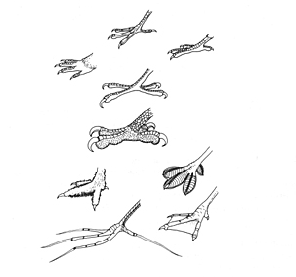|
Avian feet, like bills, tell us a great deal about the taxonomic relationships, behavior, and ecology of birds. More than half of the 9,800 species of birds, for example, are passerines, birds characterized largely by the form of their feet. The Passeriformes, or perching birds, have feet with four separate toes, three of them directed forward, and one (first, or inner, the homologue of our big toe) directed backward. All four passerine toes join the leg at the same level. Foot structure varies among the other major taxonomic groups. Some swifts have all four toes pointing forward; kingfishers have the middle and outer toes fused for part of their length; woodpeckers have two toes pointed forward and two backward (except for the "three-toed" woodpecker, in which the first toe has been lost). The four toes of raptors are highly separated. Owls can turn their fourth (outer) toe either forward or backward. Many waterbirds and shorebirds have three toes pointed forward, but the hind toe is often greatly reduced and raised so that it joins the leg above the level of the other toes and loses contact with the ground. The toes of some are completely webbed, and those of others, including such shorebirds as American Avocets, are partially webbed. These differences, of course, are related to the life-styles of the birds. The independent, extremely flexible toes of the passerines, along with the completely opposed first toe, are ideal for grasping perches. All swifts have strong claws for clinging to vertical surfaces. In some, like the White-throated, the toes all point forward in a dead individual, but in life the inner two actually work against the outer two in grasping the soft materials the swifts use in making their nests. The fused toes of kingfishers help in excavating nest tunnels; the opposing toes of woodpeckers aid in clinging to tree trunks. Birds of prey have powerful feet, strong, sharp, highly curved claws and roughened pads on the undersides of their toes to help them to readily grasp prey. The fish-eating Osprey also has spines on the pads on the soles of its toes for holding on to slippery fishes. Birds that spend a lot of time walking tend to have flat feet with a reduced backward-pointing toe; and if, like shorebirds, they often walk on soft surfaces, they usually have some webbing between the toes. And those, such as game birds, that scratch a great deal have blunt, thick claws attached to powerful legs. Ptarmigans, which walk on snow, have heavily feathered (highly insulated) feet that function as snowshoes. Ravens in the arctic have up to six times thicker, horny insulating soles on their feet than do tropical ravens. Birds with bare legs, especially those with webbed feet, avoid problems of heat loss from their extremities by circulatory adaptations.
Birds that swim generally have webbing between their toes so that the feet can be used to paddle. Lobes, rather than webbing, are often found on the toes of birds, such as American Coots, that divide their time between swimming and walking on mud. Jacanas have extremely long toes that spread their weight enough to permit them to walk on floating aquatic vegetation, including lily pads -- giving them the common name lily trotters. SEE: Swimming; Temperature Regulation and Behavior; Passerines and Songbirds. Copyright ® 1988 by Paul R. Ehrlich, David S. Dobkin, and Darryl Wheye. |
